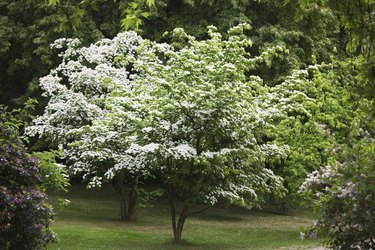
Few spring-blooming trees top the dogwood (Cornus spp.) for attractive flowers. Common flowering dogwood (Cornus florida) grows in U.S. Department of Agriculture plant hardiness zones 5 through, while kousa, or Korean, dogwood (Cornus kousa) grows in USDA zones 5 through 8. If you already have a dogwood but you're not happy with its current location, you can successfully move it to a different spot, but it's important to pick the best time of year to transplant the tree and to give it special care.
Choosing the Time
Video of the Day
The best time to transplant a dogwood is in late winter or early spring, just as the ground begins to warm and before the tree shows any signs of new growth. Choose a time that's six or eight weeks before your area is likely to experience hot summer weather, because summer heat and dryness can stress a newly transplanted dogwood. You can also move a dogwood tree in early fall, when the tree is ready to shed its leaves but the soil is still warm. This allows time for some new roots to grow before cold weather sends the tree into dormancy. Although fall transplanting is often successful, an unusually cold winter might stress the tree and interfere with its recovery in spring.
Video of the Day
Preparing the Tree
Once you've decided to transplant the dogwood, some advance planning can help ensure success. Several months before transplanting, root prune the tree to prompt growth of new feeder roots. To do this, dig down about 15 inches into the soil around the tree with a sharp spade, moving in a circle around the tree. The size of the circle depends on the size of the tree -- for example, if the tree is 6 feet tall, the circle should be about 60 inches in diameter, while a 3-foot-tall tree only needs a circle about 30 inches in diameter. After root pruning, keep the tree well watered to encourage new roots and give it extra water for a few days before you to transplant it.
Making the Move
When you're read to transplant, dig around the tree just outside of the circle you made when root pruning -- this is the size of the tree's root ball. Dig carefully to preserve as many roots as possible and wrap the ball in natural burlap as soon as you lift it, to prevent drying of the roots. Tying the ball with twine helps keep the root ball together, also preventing root damage. Prepare the hole at the new site before you move the tree, making it about twice as wide as the root ball and as deep as the tree was at the old site. Place the tree in the hole, ensure it's at the same depth as before or only slightly higher, no more than 2 inches.
Finishing the Job
Once the tree is positioned in the hole, cut the twine and fold back the burlap as far as possible. Backfill the hole with soil, making sure no burlap protrudes above the soil -- this could wick moisture away from the roots. Pack the soil down well and flood it with water so no air pockets remain around the root ball. Apply a 2- to 3-inch layer of organic mulch the area under the tree, keeping the mulch a few inches away from the trunk, to help retain moisture during summer or, for a fall-planted tree, to protect the tree from winter freeze-thaw cycles. Don't fertilize the tree for 12 months but keep it well watered, aiming for at least 1 inch per week, which includes water from rainfall.
- Missouri Botanical Garden: Cornus Florida
- Missouri Botanical Garden: Cornus Kousa
- Penn State University Extension: Growing the Flowering Dogwood Home and Garden
- University of Georgia Cooperative Extension: Growing Dogwoods
- Cornell University Cooperative Extension Rockland County: Transplanting Trees and Shrubs